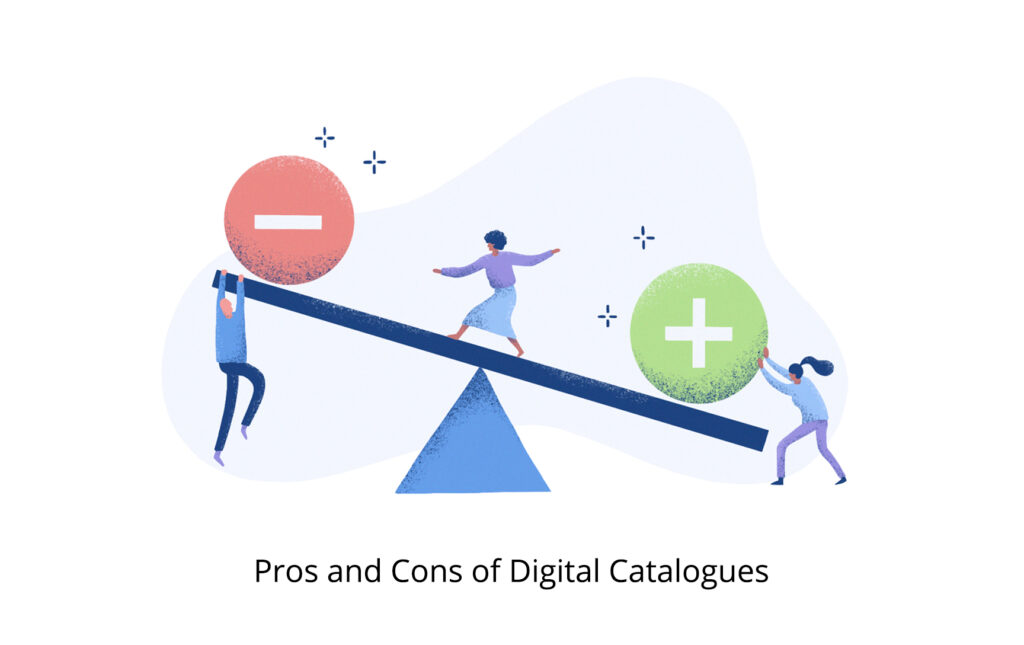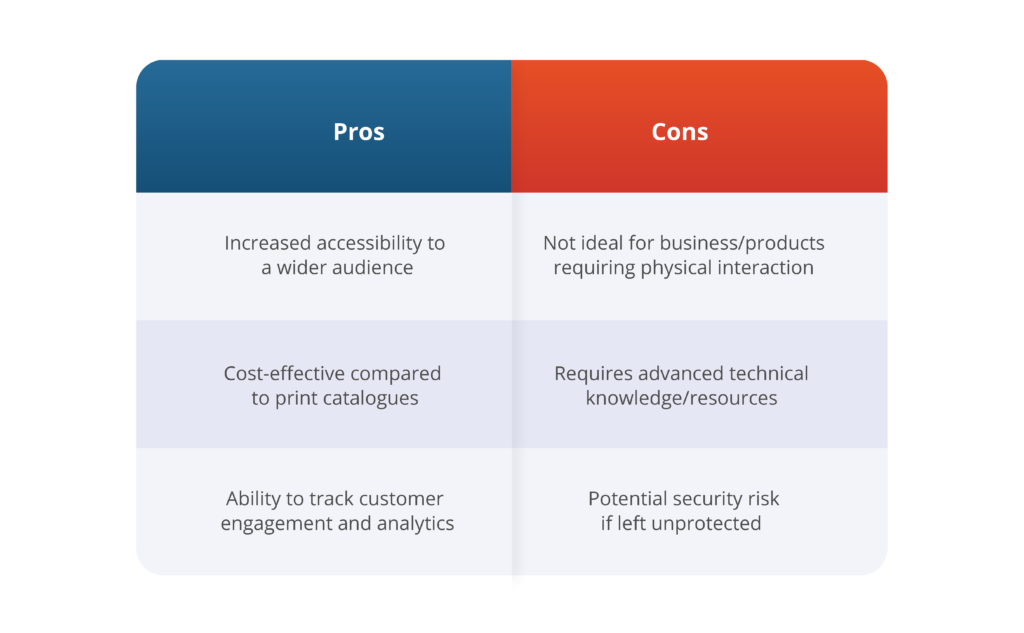In today’s digital age, it’s important for businesses to stay ahead of the curve. One way to do this is by publishing a digital catalogue instead of a print catalog. Publishing a digital catalogue with the right software can help you reach a wider audience and provide customers with easy access to your products and services. In this how-to blog post, we’ll cover why you should publish a digital catalogue, tools and methods for doing so, as well as the pros and cons of using one.
Why You Should Publish a Digital Catalogue

Digital catalogues offer a beautiful and engaging way to showcase your brand’s products and services. With the rise of mobile devices, publishing a digital catalogue has become even more important, as customers are increasingly accessing content from their Android phones or tablets. By publishing online, you can reach a wider audience than with print catalogs alone.
Using catalog software can also help lower costs associated with printing and distribution. Since digital catalogs require no physical materials or shipping fees, you’ll save on expenses while still providing an immersive experience for potential customers.
Overall, by creating a digital catalogue that is optimized for search engines and easy to navigate, businesses can increase sales and revenue by making it easier for customers to find what they’re looking for. With these benefits in mind, it’s clear why publishing a digital catalogue should be part of any business owner’s marketing strategy.
Reach a Wider Audience
With a digital catalog, you can reach a wider audience through online platforms. Your catalog software can be easily accessible on mobile devices using Android or iOS apps, allowing customers to browse your content from anywhere in the world. By making your catalog beautiful and shareable on social media and email, you can quickly and effortlessly reach more potential customers than with print catalogs alone. Additionally, by ensuring that your digital catalog is designed with accessibility in mind, it becomes a valuable resource for all customers regardless of their abilities or disabilities.
Lower Costs
By publishing a digital catalog, businesses can significantly lower costs compared to traditional print catalogs. There are no printing or shipping expenses with a digital catalog, which reduces overall production costs. Additionally, there are fewer design fees required for a digital catalog since the process is streamlined and automated through specialized software.
Another cost-saving benefit of using digital catalogs is the ability to update content without incurring additional expenses. This means that brands can make real-time changes to their product offerings or promotions effortlessly and at no extra cost. With easy-to-use catalogue software available on both Android and desktop platforms, creating beautiful and engaging content has never been easier while lowering overall production costs.
Increase Sales and Revenue
Real-time sales tracking and analytics can provide valuable insights into customer behavior, allowing businesses to make informed decisions on how to improve their digital catalogs. Interactive features like clickable links can drive engagement and conversions by making it easier for customers to explore products or services. Additionally, the ability to personalize recommendations based on customer behavior creates a more seamless shopping experience that is tailored specifically to each individual’s preferences. By utilizing these features within catalog software, brands can increase sales and revenue without having to rely solely on traditional print catalogs.
Tools and Methods for Publishing a Digital Catalogue
Digital catalogues have become increasingly important for businesses looking to expand their reach and make their products more accessible to customers. One way to achieve this is by using SaaS solutions specifically designed for digital catalogue publishing. These tools offer a range of features such as the ability to create interactive PDFs, flipbooks, and responsive website catalogues. Each tool has its advantages and disadvantages, so it’s important for business owners to carefully evaluate which solution best meets their needs before making a decision on which one to use.
SaaS Solutions for Digital Catalogue Publishing
Access advanced analytics and insights to enhance your digital catalogue’s performance. With SaaS solutions for digital catalogue publishing, you can track user behavior, measure engagement rates, and optimize content accordingly. Additionally, enjoy easy customization of templates to match your brand with the help of built-in design tools.
Collaboration features for remote teams streamline the process of creating a digital catalog. Shared access allows multiple team members to work simultaneously on different parts of the project in real-time. These cloud-based software solutions ensure that all stakeholder feedback is efficiently incorporated into the final product resulting in a polished end-product that’s ready for online publication.
Using Flipbooks and Interactive PDFs
Engage customers with interactive elements like videos or animations within your digital catalogues to create a memorable shopping experience. The ability to track user engagement and gather data on customer behavior helps you identify popular products, improve marketing strategies and optimize the content of future catalogs effectively. Compared to traditional print catalogs, digital publishing is a cost-effective solution that saves money on printing costs while also reducing waste in landfills – making it an eco-friendly option for businesses looking to go green.
While flippable digital catalogues offer an interactive and engaging reading experiences, businesses should avoid using flipping software that converts PDFs into digital catalogs. The flipping motion can be distracting and disorienting, making it difficult for customers to focus on the content. Additionally, the small font sizes and lack of zoom functionality often make reading the product descriptions and specifications challenging. Overall, a bad reading experience can result in a loss of sales and negatively impact the brand’s reputation.
Creating a Responsive Website Catalogue
When creating a responsive website catalogue, it’s important to optimize the design for mobile devices. With more and more customers on-the-go, this makes it easier for them to access your products and services from any device. Additionally, a SEO-friendly design can improve search engine rankings and increase visibility online.
Integration with e-commerce platforms is another crucial feature of a digital catalogue. This allows customers to make purchases directly from the catalog, streamlining the buying process and increasing sales potential. By focusing on these key features when publishing your digital catalogue online, you can reach a wider audience and provide an effortless shopping experience for your customers.
Pros and Cons of Digital Catalogues

Digital Catalogues offer a wide range of benefits for businesses looking to reach a broader audience. With digital catalogues, you can easily update and modify your products and services without the need for printing new copies. Additionally, it’s easier to track customer engagement with your catalogue through analytics tools.
However, one potential downside is that not all customers may have access or be comfortable using technology to browse through a digital catalogue compared to traditional print options. It’s important to consider your target audience before deciding whether or not publishing a digital catalogue is the right choice for your business.
Pros
Increased accessibility to a wider audience is one of the main benefits of publishing a digital catalogue. Unlike print catalogues, which are limited by physical distribution and cost, digital catalogues can be easily accessed online by anyone with an internet connection. This allows you to reach a wider audience and potentially increase your customer base.
Some other benefits include:
- Cost-effective compared to print catalogues
- Ability to track customer engagement and analytics
Cons
May not be suitable for all types of businesses or products. Digital catalogues may not work for every type of business or product, especially those that require a physical touch or feel before purchase.
Requires technical expertise and resources to create and maintain. Publishing a digital catalogue requires advanced technical knowledge and resources to ensure its successful creation and maintenance over time.
Potential for security vulnerabilities if not properly secured. Digital catalogues are susceptible to security risks such as hacking, phishing, malware attacks if they are not adequately secured with the proper measures in place.
- Not ideal for businesses/products requiring physical interaction
- Requires advanced technical knowledge/resources
- Potential security risks if left unprotected
To summarize, here are side by side comparisons of the Pros and Cons of Digital Catalogues

Publish your digital catalogue using MagLoft
If you’re looking for a user-friendly and safe platform to publish your digital catalogue, MagLoft is an excellent solution. With MagLoft, you don’t need to have any technical expertise to create and maintain a professional-looking digital catalogue. The platform is designed to be intuitive, straightforward, and accessible to anyone. You can easily upload your existing PDF catalogue, and MagLoft will convert it to an interactive and engaging digital format that can be accessed on any device.
Another significant advantage of using MagLoft is the platform’s robust security measures. MagLoft takes security very seriously and has implemented various measures to ensure your digital catalogue is protected against potential security risks. Additionally, MagLoft regularly updates its security protocols and proactively identifies and addresses potential threats.
MagLoft also provides comprehensive analytics and tracking tools that allow you to monitor customer engagement and adjust your digital catalogue accordingly. You can track metrics such as page views, time spent on pages, click-through rates, and much more. With this data, you can gain insights into your customers’ behavior and preferences, which can help you refine your marketing strategy and improve your products and services.
Conclusion
In conclusion, publishing a digital catalogue can provide numerous benefits for businesses. Not only does it allow for wider accessibility to products and services, but it also provides cost-effectiveness and the ability to track customer engagement. By utilizing features such as interactive media, personalization options, and searchability, businesses can enhance their online presence and ultimately increase sales.
Overall, transitioning from traditional print catalogs to digital ones is an important step in today’s technology-driven world. With the ease of access that comes with online catalogs, businesses have the opportunity to showcase their offerings to a larger audience while also providing a more immersive shopping experience for customers.
In conclusion, MagLoft is an excellent option for businesses looking to convert their existing PDF catalogue into an interactive and engaging digital format. The platform is user-friendly, secure, and provides robust analytics tools to help businesses optimize their digital catalogs. Whether you are a small business owner or a large publishing house, MagLoft can help you take your catalog to the next level and reach a wider audience.

